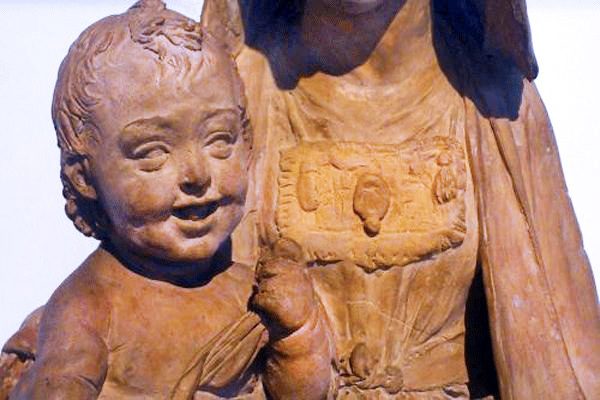Leonardo da Vinci was rumored to have made sculptures, but until now there has been no existing three-dimensional work identified as his own. Scholars believe that a sculpture formerly attributed to Antonio Rossellino was misattributed and that it is actually a work of the Renaissance genius.
“The Virgin with the Laughing Child” has been a part of the Victoria and Albert Museum in London since 1858 and was credited to Rossellino by the influential late art historian and British Museum director John Pope-Hennessy. According to Francesco Caglioti, the Italian scholar curator for the Florence exhibition that is featuring the statue, Pope-Hennessy had no evidence for the Rossellino ruling and often made such attributions on a whim. The exhibition called “Verrocchio: Master of Leonardo,” is at Florence’s Palazzo Strozzi.
Caglioti, an art history professor, was something of an art history prodigy, having made a catalog of the Louvre when he was eight. He said that the sculpture has many of the telltale fingerprints of da Vinci: The Virgin Mary has the signature enigmatic smile, the fabric of her dress mimics drawings of folds and draperies that da Vinci was employing in his paintings of the time. Also the realism of the giggling baby Christ is typical of da Vinci, whose drawings of children showed a similar attention to expression. Caglioti’s claim has been supported by da Vinci scholar Carmen C. Bambach, from the Metropolitan Museum in New York.
Leonardo da Vinci is thought to have created the 20 inch tall terra-cotta sculpture around the year 1472, while working under the Italian master painter Andrea del Verrocchio. He would have been 19 or 20 years old at the time. A da Vinci attribution was actually attempted in 1899, but the proposal was only reopened by Caglioti this week. “The Virgin with the Laughing Child” joins the “Nude Mona Lisa,” as two recent works that have brought examination and a degree of controversy to centuries old works, in this, the 500th year anniversary of Leonardo’s death. The drawing, known as the Monna Vanna, was originally thought to have been made by a student of da Vinci, but the Louvre believes that the Renaissance master himself was behind it.
This charcoal drawing of a naked woman, posed just like his renowned portrait of the Mona Lisa, goes on exhibition in Paris later this year. The Louvre has detected Leonardo’s own hand in it and also his sense of humor.
Leonardo worked obsessively on the Mona Lisa for years and kept the painting with him until his death in 1519. In the portrait, Lisa Gherardini del Giocondo, the Florentine woman who posed for it, wears a silk head covering that is almost too thin to see. Subtle mysteries resonate from her shadowed eyes and restrained smile. Every detail in the painting is executed in such detail that it is easy to believe that the Mona Lisa haunted the great master. The Monna Vanna (vain woman) on the other hand, is executed with such bluntness that it may have been a bit of an artistic release valve. If it was drawn by Leonardo, perhaps it was simply a way for artist to blow off steam.





